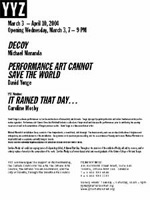Michael Maranda
Catalogue essay

“Michael Maranda’s Ascesis of the Object.”
YYZ newspaper, date 2003
Tim Lilburn
The piece — two harpsichords surrounded by emptiness — is called
“Decoy.” It looks like the love of reason; here is the eighteenth century,
here rational inquiry’s liberation from the suffocation of authority and subjectivity.
Our credulity rushes forward: we’ve had this particular overcoming on our minds
for 250 years; it’s a kind of home. Once we are three feet from the work, we
see the instruments are unplayable dummies; the music (the Goldberg Variations),
appearing suddenly, is mangled.
Here is an imitation of the triumph of reason that doesn’t work very hard to hide the fact that it’s a fake.
***
Time was when Reason seemed a winged thing. It recently had wed a stunningly
fecund science — the microscope, the telescope, heliocentrism, the circulation
of blood, moons of Jupiter: together they would lift all from the fusty oppressions
of religion and capricious rule. The energy flowed into this dream: euphoria.
***
The side-curves of Maranda’s harpsichords, precise, sensuous, are a memory
of reason’s apotheosis. Human, artifactual, they are nevertheless wing-like,
breathlessly transcendent — and sexual: thinking’s auto-eroticism.
***
The Critique of Pure Reason, Preface to the Second Edition: the inconclusive,
the raw, the fragmentary, the equivocal, the stammering in thinking, Kant insists,
should make all of us nervous; these are signs that what is going on--under
the name metaphysics, of soulcraft — is not, in fact, thinking at all,
but affect; wankery camouflaging itself as foundational probing. Here cognition
has missed “the secure path of science” and infantilely remained
subjectivity. It should be abandoned as a serious undertaking; unhappily, though,
it must be admitted that the impulse urging this particular subjectivity will
remain, the source of the natural tragedy of the mind.
Reason is concerned properly with the discovery of the necessary law;
it must not allow itself to be kept “in nature’s leading strings,”
but “must constrain nature to give answer to questions of reason’s
own determining.” By such interrogation, “the study of nature has
entered on the secure path of science, after having for so many centuries been
nothing but a process of merely random groping.” Metaphysics is quintessentially
random groping: no unanimity appears, but a wilderness of contesting views.
Here the mind (oh, why?) is deceitful; it lures us on, roils us forward
with terrible exigence, then betrays us.
Antithetical to the true labour of reason on the secure path of science are
the musings of visionary charlatans (Schwärmerei), whose father is Plato,
mystical, poetic.
***
The thin legs of Maranda’s harpsichords give a hint of weightlessness
to the body of the instruments — they are feathery, fine, yet not Romantic
because precise, geometric; this is the intelligence that was to lead us from
beneath superstition’s evil weight, what the humanistic nobility of democracy
would look like as furniture; the legs, the instruments, nod toward flight,
but — behold, amazingly — are not aloft. Here is the form —
the decoy — of transcendence — it manfully (heroically, altruistically)
refuses transcendence.
***
The water-like shapes of the harpsichord, the sides that swoop like thinking:
the way the two “instruments” are assembled seems elegant, inevitable,
like successful systematic argument. The strings are as ordered as the wires
of a telephone grid — clean, utopian: the human overcoming of things.
One is impressed by the workmanship in Maranda’s harpsichords, the intricacy
of this work, but the machines clearly won’t do what they seem to be made
to do. What’s on display is driven labour detached from intention. The
unconnectedness of craftsmanship and intentionality is dizzying. The objects
appear lonely for their use. They also seem to lose a portion of their beauty
in this deprival.
***
Why such harsh fakery, a humiliation of things? Sheer them of their utility
and they look awkward, rebuked. What’s the point of all this labour, the
two finely-constructed harpsichords, the wronghandedly played Bach, a labour
that carefully refuses teh achievement of purpose? This is a chartening of the
object, a striking off of the encrustations of utility and beauty. This ascesis
of objects, purging them of meaning, significance, allows some distance to return
to them, a touch of unlikeliness, ferality; autonomy seeps into the things through
the gaps in Maranda’s achievement.
But to imagine he rescues the pure object by thus operation is to lapse into
yet another Romanticism (is there no end to them?) — a Heideggerian Kantianism,
this time. Maranda simply subjects things to an ascetical reduction: who knows
what will result? But what was before — object as beautiful, object as
useful — was just a shunning of thing-hood, a clouding over of specificity
with human wanting. The objects emerge from the prison of this domination shaky,
pale, undetermined — possibly irrevocably broken in spirit. But there
they stand, shorn, weak, and no longer ours.